Heinrich J.G., Aldinger F. (Eds.) Ceramic Materials and Components for Engines
Подождите немного. Документ загружается.

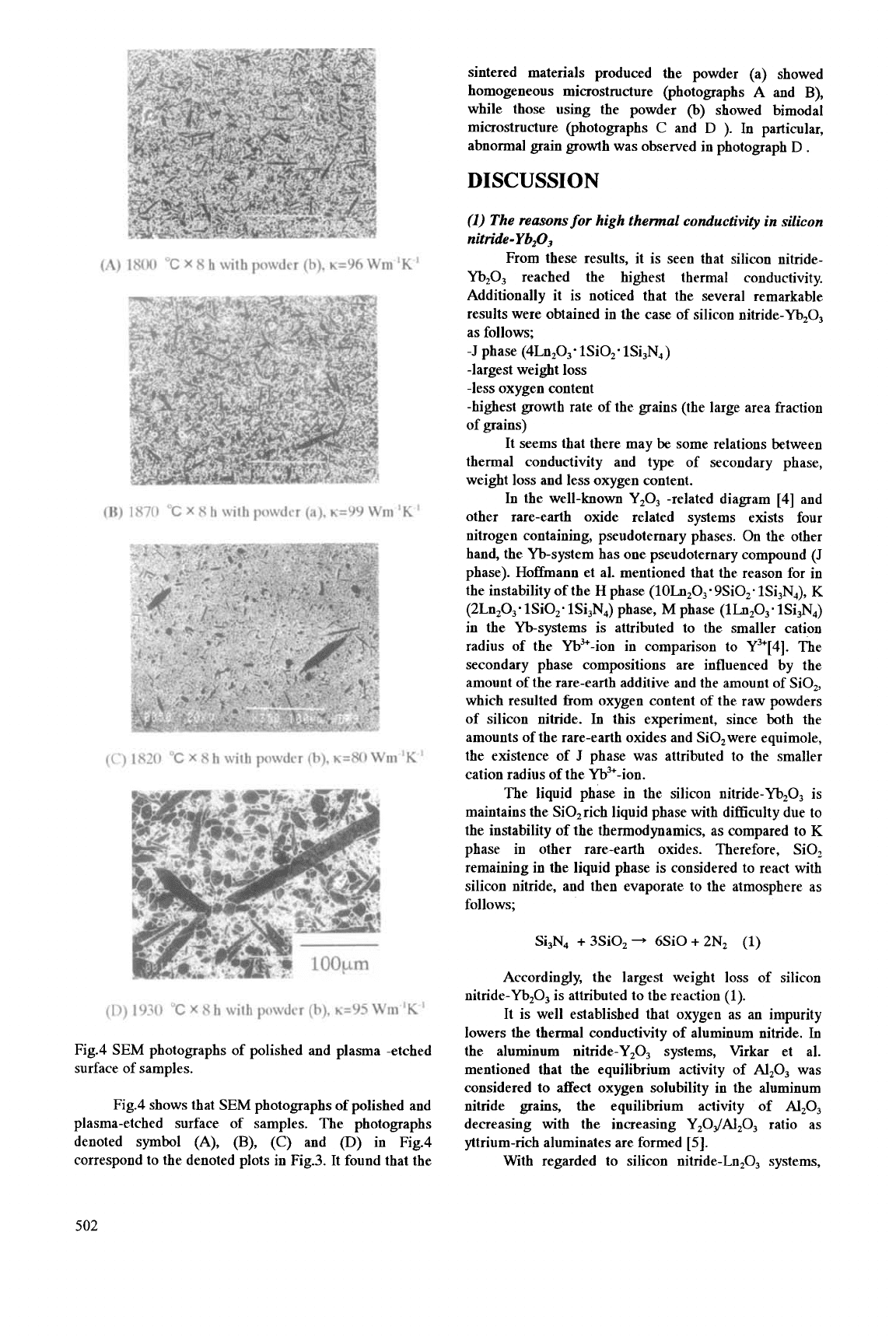
(A)
1800
oc
x
8
h
with powder (b),
K=96
Wm-'K-l
Yb,03
reached the highest thermal conductivity.
Additionally it is noticed that the several remarkable
other rare-earth oxide related systems exists four
nitrogen containing, pseudoternary phases.
On
the other
hand, the Yb-system has one pseudoternary compound
(J
phase). Hoffmann et al. mentioned that the reason for in
the instability of the
H
phase (lOLn,O3-9Si0,-1Si,N,),
K
(2Ln,O,.
lSi0,. 1Si3N,) phase,
M
phase (lh,O,. lSi,N,)
in the Yb-systems is attributed to the smaller cation
radius of the Yb3'-ion in comparison to Y3'[4]. The
secondary phase compositions are influenced by the
amount of the rare-earth additive and the amount of SiO,,
which resulted from oxygen content of the raw powders
of
silicon nitride. In this experiment, since both the
amounts of the rare-earth oxides and Si0,were equimole,
the existence of
J
phase was attributed to the smaller
cation radius
of
the =3+-ion.
The liquid phase in the silicon nitride-Yb,O, is
maintains the Si0,rich liquid phase with difficulty due to
the instability of the thermodynamics, as compared to
K
phase in other rare-earth oxides. Therefore, SiO,
remaining in the liquid phase is considered to react with
silicon nitride, and then evaporate to the atmosphere
as
follows;
@)
lS7O
"'
with
powder
(a)'
K=99
wm
(c)
1820
"c
X
8
h with powder
(b),
~=80
Wm 'K1
Si,N,
+
3Si0,
-
mi0
+
2N,
(1)
Accordingly, the largest weight loss of silicon
nitride-Yb,O, is attributed to the reaction (1).
It is well established that oxygen
as
an impurity
lowers the thermal conductivity of aluminum nitride.
In
Fig.4
SEM
photographs of polished and plasma -etched the aluminum nitride-Y,O, systems, Virkar et
al.
surface of samples. mentioned that the equilibrium activity of
Al,O,
was
considered to affect oxygen solubility in the aluminum
Fig.4 shows that
SEM
photographs
of
polished and nitride grains, the equilibrium activity of
Al,O,
plasma-etched surface of samples. The photographs decreasing with the increasing Y,OJAI,O, ratio as
denoted symbol (A),
(B),
(C)
and
(D)
in Fig.4 yttrium-rich aluminates are formed
[5].
correspond to the denoted plots in Fig.3. It found that the With regarded to silicon nitride-Ln,O, systems,
(D)
1930
"C
X
8
h with powder (b),
~=95
Wm-'K-'
502

Yokota et al. reported that the thermal conductivity of
silicon nitride increased as the impurities in the grains
decreased by using a p-silicon nitride raw powder of
high-purity [6]. Yokota also reported that since oxygen
was the major impurity in the grains, the high thermal
conductivity was thus achieved by reducing the oxygen
content of the grains.
Therefore, it can
be
said that the liquid phase (J
phase) associated with high Yb,OJSiO, ratio, in
otherwords ytterbium-rich silicates during the grain
growth in comparison to K phase of other rare-earth
oxides should have lower oxygen solubility in the silicon
nitride grains. Additionally the high growth rate of
silicon nitride-Yb,O, enhances the removal of oxygen
from the grains.
Hirosaki
et
al. reported that significant
improvement of thermal conductivity
is
due to decrease
in two grain junctions accompanying grain growth [l].
In
this experiment, since the thermal conductivity of silicon
nitride-Ln,O, increased with the area fraction of large
grains, the high thermal conductivity
is
also here
attributed to
a
decrease in two grain junctions as grain
growth.
Therefore, thermal conductivity of silicon nitride-
Ln,O,
depends
on
the type of additive, the highest
thermal conductivity of 121 Wm 'K' being achieved by
the silicon nitride-Yb,O,.
(2)
Compatiblity between high thermal
conductivity
and
high mechanical strength
600
cj
s
3
500
F:
c
m
3
400
i?
a
3
300
L
Powder(b)
'.
,
'0
,
80
85
90 95
100
105
Thermal
conductivity/Wm
K
-1 -1
Fig.5 Relation between thermal conductivity and flexural
strength.
Fig.5 shows that relation between thermal
conductivity and flexural strength. The sintered materials
grown from powder (a) have both thermal conductivity
of approximately
100
Wm%' and flexural strength of
approximately
550
MPa in striking contrast to those
grown from powder (b). Fracture toughness
of
the
sintered materials grown from the powder (a) was
6
MPa m1l2
It is appears from this data that it is difficult to
obtain high thermal conductivity and good mechanical
properties with
a
bimodal microstructure. This would be
because large elongated grains are considered to be the
origin of cracks, when flexural testing is done.
Therefore, it can
be
said that the achievement of
both high thermal conductivity and sufficient mechanical
properties by using the powder (a) due to the
homogeneous microstructure of the sintered material
achieved thereby
.
Emoto et al. investigated that the grain growth
behavior of fine-grained p-silicon nitride with varying
amounts
of
nuclei, and they concluded that the grain
growth driving force depended
on
the amount of nuclei
in the silicon nitride raw powder
[7].
In
this experiment as well, the difference of the
microstructure of the sintered materials between powder
(a) and (b)
is
considered to
be
the amount of nuclei in the
silicon nitride raw powders.
SUMMARY
We have newly developed a silicon nitride
substrate with a thermal conductivity of 100 Wm-'K'.
A
high thermal conductivity with sufficient mechanical
properties was achieved by processing the high purity
raw powder of p-silicon nitride with ytterbium oxide
as
an additive and developing the homogeneous
microstructure of a sintered material. This material
densified to over
99
%
of the theoretical density at the
sintering temperature of
1800
"C
for
8
h
under a
nitrogen pressure
of
0.9
MPa.
In
this material, the
flexural strength was between
550
and 600 MPa, and
fracture toughness was 6 MPa-m"'. It
is
thus considered
that this material could
be
an attractive substrate for the
power modules.
REFERENCES
(1) N.Hirosaki, Y.Okamoto, M.Ando, EMunakata,
and
Y.Akiume, Thermal Conductivity of Gas-Pressure-
Sintered Silicon Nitride, J.AmCeruni.Soc., 79
[ll]
(1996) 2878-82
(2) K.Hirao, K.Watari, M.E.Brito, M.Toriyama, and
S.Kanzaki, High Thermal Conductivity in Silicon
Nitride with Anisotropic Microstructure,
.JAnr.
Ceruni.Soc.,79
[9]
(1996) 2485-SS
(3) K.Watari, K.Hirao, M.E.Brito, M.Toriyama, and
S.Kanzaki, Hot Isostatic Pressing to Increasing
Thermal Conductivity of Si,N, Ceramics,
J.Muter.Res.,
14 [4] (1999) 1538-1541
(4) L.J.Gaukler, H.Hohnke, and T.Y.Tien, The System
Si,N, J.AmCerum.Soc.,63
[35]
(1973)
(5)
A.V.Virkar, T.B.Jackson, and R.A.Culter,
Thermodynamic and Kinetic Effects and Oxygen
Removal
on
the Thermal Conductivity
of
Alumminum Nitride, J.AnrCeruni.Soc., 72
[
111
(1989) 2031-42
(6) H.Yokota and M.Ibukiyama, to be published.
(7) H.Emoto and M.Mitomo, Control and
503

Characterization
of
Abnormally Grown Grains in
Silicon Nitride Ceramics,
J.Euro.CerumSoc.,
[17](1997) 797-804
5
04
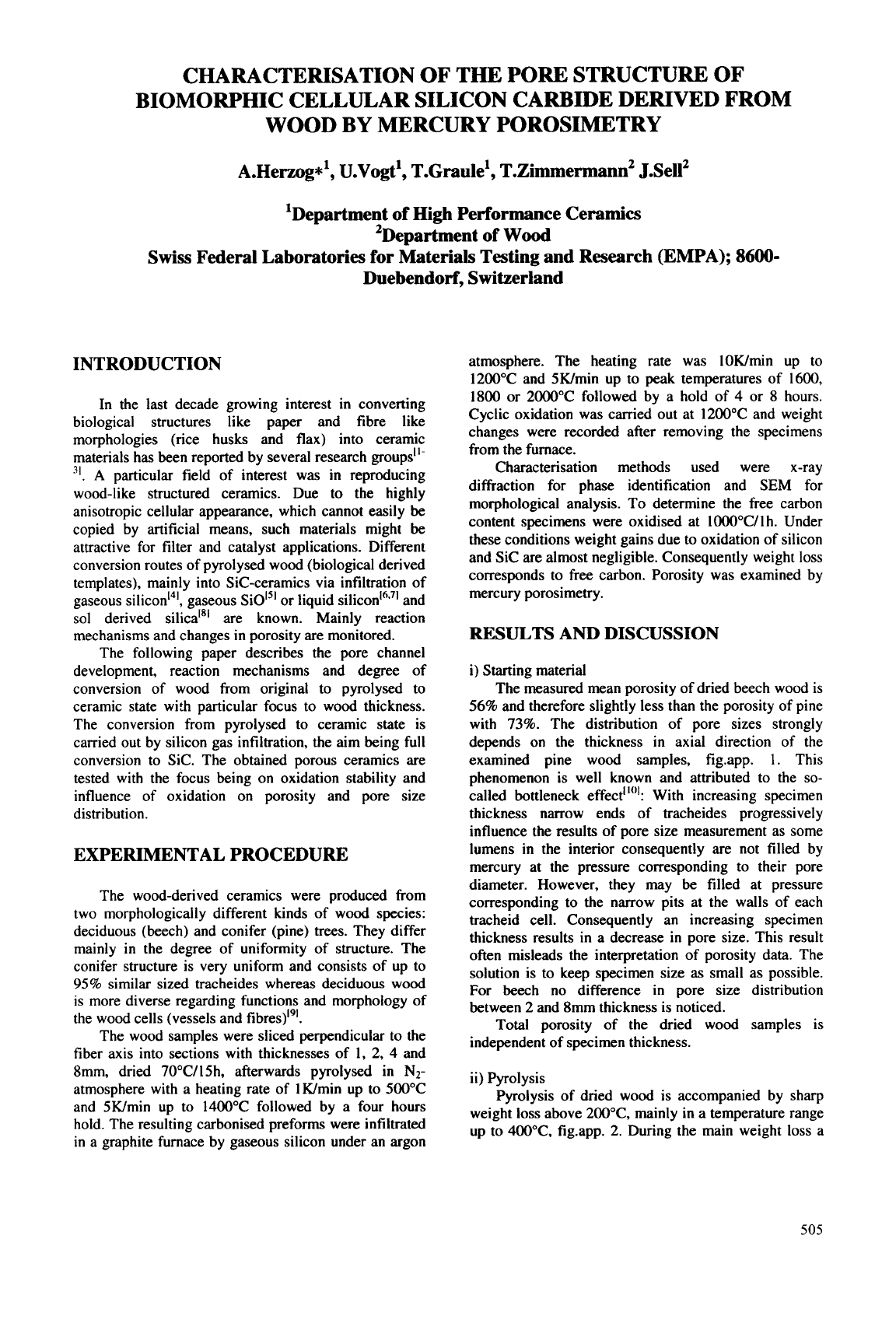
CHARACTERISATION
OF
THE PORE STRUCTURE
OF
BIOMORPHIC CELLULAR SILICON CARBIDE DERIVED FROM
WOOD BY MERCURY POROSIMETRY
A.Hemg*',
U.Vogt',
T.Graule', T.Zimmermann2 J.Sel12
'Department of High Performance Ceramics
2Department
of
Wood
Swiss Federal Laboratories for Materials Testing and Research (EMPA);
8600-
Duebendorf, Switzerland
INTRODUCTION
In the last decade growing interest
in
converting
biological structures like paper and fibre like
morphologies (rice husks and flax) into ceramic
materials has been reported by several research groups"-
3'.
A
particular field of interest
was
in
reproducing
wood-like structured ceramics. Due to the highly
anisotropic cellular appearance, which cannot easily
be
copied by artificial means, such materials might be
attractive for filter and catalyst applications. Different
conversion routes of pyrolysed wood (biological derived
templates), mainly into Sic-ceramics via infiltration of
gaseous silicon14', gaseous SiO'"
or
liquid silicon'"'' and
sol
derived silica'8' are known. Mainly reaction
mechanisms and changes
in
porosity are monitored.
The following paper describes the pore channel
development, reaction mechanisms and degree of
conversion of wood from original to pyrolysed to
ceramic state
with
particular focus to wood thickness.
The conversion from pyrolysed to ceramic state
is
carried out by silicon gas infiltration, the aim being
full
conversion to Sic. The obtained porous ceramics are
tested
with
the focus being on oxidation stability and
influence of oxidation on porosity and pore size
distribution.
EXPERIMENTAL PROCEDURE
The wood-derived ceramics were produced from
two morphologically different kinds of wood species:
deciduous (beech) and conifer (pine) trees. They differ
mainly
in
the degree of uniformity of structure. The
conifer structure is very uniform and consists of up to
95% similar sized tracheides whereas deciduous wood
is more diverse regarding functions and morphology of
the wood cells (vessels and fibres)'".
The wood samples were sliced perpendicular to the
fiber axis into sections
with
thicknesses of
I,
2, 4 and
8mm, dried 70"C/15h, afterwards pyrolysed
in
Nz-
atmosphere
with
a heating rate of lWmin up to 500°C
and SWmin
up
to 1400°C followed by a four hours
hold. The resulting carbonised preforms were infiltrated
in
a graphite furnace by gaseous silicon under an argon
atmosphere. The heating rate was IOWmin
up
to
1200°C and SWmin up to peak temperatures of
1600,
1800 or 2000°C followed by a hold of
4
or
8 hours.
Cyclic oxidation was carried out at 1200°C and weight
changes were recorded after removing the specimens
from the furnace.
Characterisation methods used were x-ray
diffraction for phase identification and SEM for
morphological analysis. To determine the free carbon
content specimens were oxidised at 1O0O0C/1 h. Under
these conditions weight gains due to oxidation of silicon
and Sic are almost negligible. Consequently weight loss
corresponds
to
free carbon. Porosity was examined by
mercury porosimetry.
RESULTS
AND DISCUSSION
i)
Starting material
The measured mean porosity of dried beech wood
is
56%
and therefore slightly less than the porosity of pine
with 73%. The distribution of pore sizes strongly
depends
on
the thickness
in
axial direction of the
examined pine wood samples, fig.app.
1.
This
phenomenon
is
well known and attributed to the
so-
called bottleneck effect'"": With increasing specimen
thickness narrow ends of tracheides progressively
influence the results of pore size measurement as some
lumens in the interior consequently are not filled by
mercury at the pressure corresponding to their pore
diameter. However, they may
be
filled at pressure
corresponding to the narrow pits at the walls of each
tracheid cell. Consequently an increasing specimen
thickness results in a decrease
in
pore size. This result
often misleads the interpretation of porosity data. The
solution is to keep specimen size
as
small as possible.
For
beech
no
difference
in
pore size distribution
between 2 and 8mm thickness is noticed.
Total porosity of the dried wood samples is
independent of specimen thickness.
ii)
Pyrolysis
Pyrolysis of dried wood is accompanied by sharp
weight loss above 200"C,
mainly
in
a temperature range
up to 400"C, fig.app.
2.
During the main weight
loss
a
505
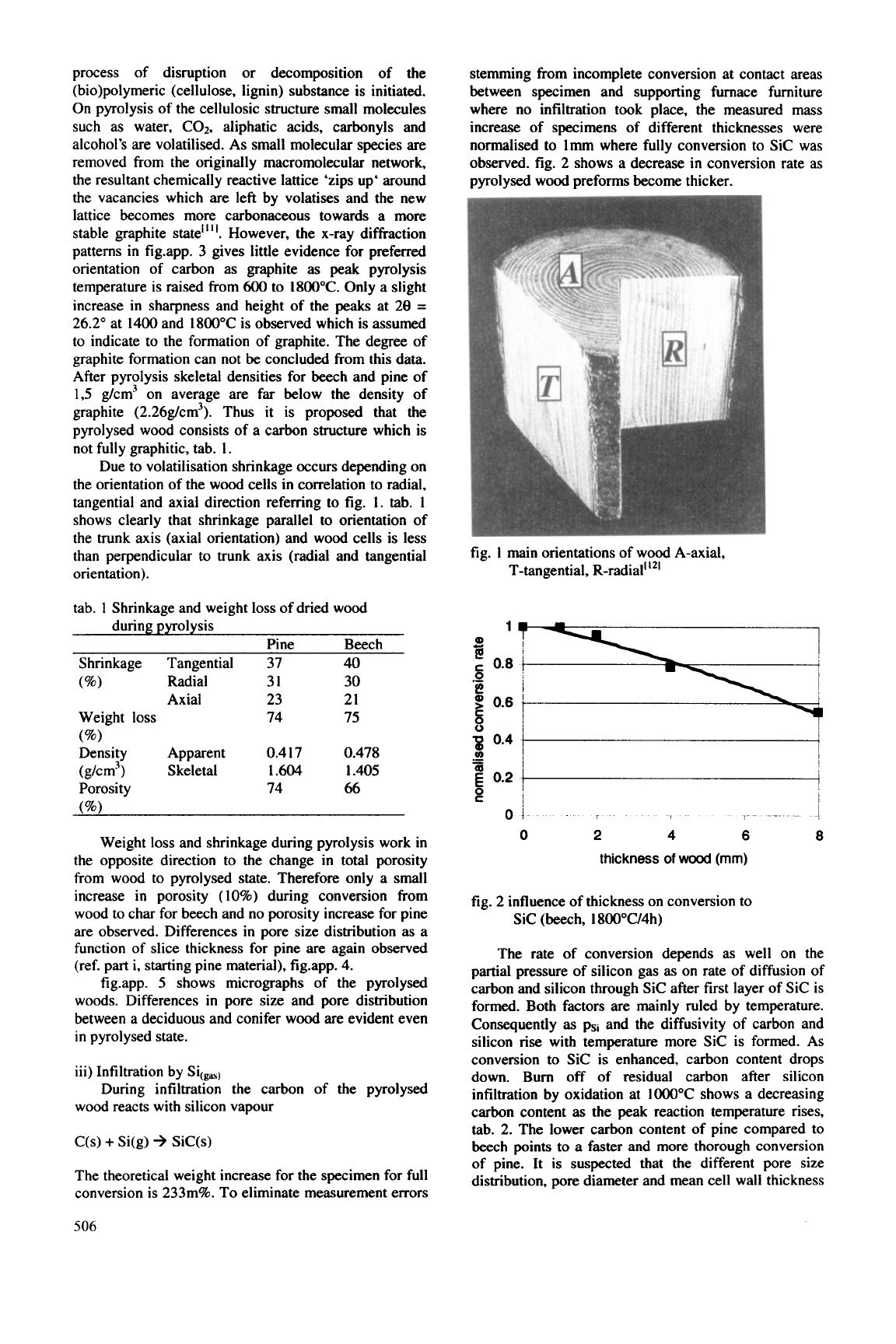
process of disruption
or
decomposition of the
(bio)polymeric (cellulose, lignin) substance is initiated.
On
pyrolysis of the cellulosic structure small molecules
such
as
water, CO2, aliphatic acids, carbonyls and
alcohol's are volatilised. As small molecular species are
removed from the originally macromolecular network,
the resultant chemically reactive lattice 'zips up' around
the vacancies which are left by volatises and the new
lattice becomes more carbonaceous towards a more
stable graphite state"". However, the x-ray diffraction
patterns
in
fig.app. 3 gives little evidence for preferred
orientation of carbon as graphite as peak pyrolysis
temperature is raised from
600
to 1800°C. Only a slight
increase in sharpness and height of the peaks at 28
=
26.2" at 1400 and 1800°C is observed which is assumed
to indicate to the formation of graphite. The degree of
graphite formation can not be concluded from
this
data.
After pyrolysis skeletal densities for beech and pine of
1,5 g/cm3
on
average are far below the density of
graphite (2.26g/cm3). Thus it is proposed that the
pyrolysed wood consists of a carbon structure which is
not fully graphitic, tab.
1.
Due to volatilisation shrinkage occurs depending on
the orientation of the wood cells in correlation to radial,
tangential and axial direction refemng to fig.
1.
tab.
1
shows clearly that shrinkage parallel to orientation of
the
trunk
axis (axial orientation) and wood cells is less
than perpendicular to trunk axis (radial and tangential
orientation).
tab.
1
Shrinkage and weight
loss
of dried wood
during pyrolysis
Pine Beech
Shrinkage Tangential 37
40
Weight
loss
74 75
(%)
Density Apparent 0.417 0.478
(
g/c
m')
Skeletal 1.604 1.405
Porosity 74 66
(%)
(%)
Radial 31 30
Axial 23 21
Weight
loss
and shrinkage during pyrolysis work in
the opposite direction to the change in total porosity
from wood to pyrolysed state. Therefore only a small
increase
in
porosity
(10%)
during conversion from
wood to char for beech and no porosity increase for pine
are observed. Differences
in
pore size distribution as a
function of slice thickness for pine are again observed
(ref. part i, starting pine material), fig.app. 4.
fig.app.
5
shows micrographs of the pyrolysed
woods. Differences
in
pore size and pore distribution
between a deciduous and conifer wood are evident even
in
pyrolysed state.
iii)
Infiltration
by
Si(ga5)
During infiltration the carbon
of
the pyrolysed
wood reacts with silicon vapour
C(s)
+
Si(g)
+
SiC(s)
The theoretical weight increase for the specimen for full
conversion is 233m%. To eliminate measurement errors
stemming from incomplete conversion at contact areas
between specimen and supporting furnace furniture
where
no
infiltration took place, the measured mass
increase of specimens of different thicknesses were
normalised to lmm where
fully
conversion to Sic was
observed. fig. 2 shows a decrease in conversion rate as
pyrolysed wood preforms
become
thicker.
fig.
I
main orientations of wood A-axial,
T-tangential, R-radial"*'
-g
0.4
1
Oi
.-
1
0
2
4
6
8
thickness
of
wood
(mm)
fig. 2 influence of thickness
on
conversion to
Sic (beech, 1800"C/4h)
The rate of conversion depends as well on the
partial pressure of silicon gas
as
on rate of diffusion of
carbon and silicon through Sic after first layer of Sic is
formed. Both factors are mainly ruled by temperature.
Consequently
as
psi and the diffusivity
of
carbon and
silicon rise with temperature more Sic is formed. As
conversion to Sic
is
enhanced, carbon content drops
down. Bum
off
of residual carbon after silicon
infiltration by oxidation at lO00"C shows a decreasing
carbon content
as
the peak reaction temperature rises,
tab. 2. The lower carbon content of pine compared to
beech points to a faster and more thorough conversion
of pine. It is suspected that the different pore size
distribution, pore diameter and mean cell wall thickness
506
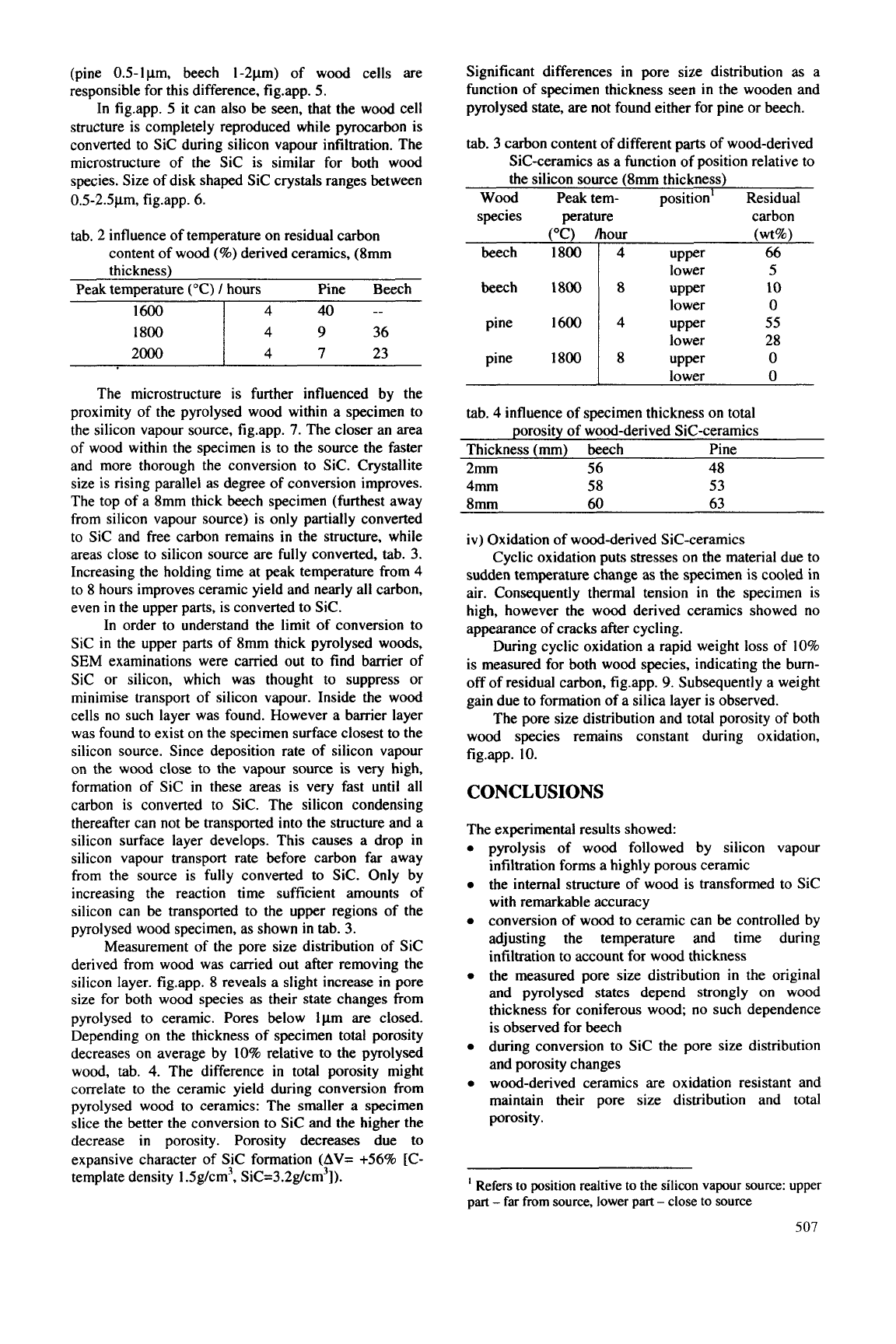
(pine 0.5-Ipm, beech 1-2pm) of wood cells are
responsible for this difference, fig.app.
5.
In fig.app.
5
it
can also be seen, that the wood cell
structure is completely reproduced while pyrocarbon is
converted to
Sic
during silicon vapour infiltration. The
microstructure of
the
Sic is similar for both wood
species. Size of disk shaped Sic crystals ranges
between
0.5-2.5pm, fig.app. 6.
1600
1800
2000
tab.
2
influence of temperature on residual carbon
content of wood
(%)
derived ceramics, (8mm
thickness)
Peak temperature ("C)
I
hours Pine Beech
4 40
__
4
9
36
4
7
23
The microstructure is further influenced by the
proximity of the pyrolysed wood within a specimen to
the silicon vapour source, fig.app.
7.
The closer an area
of
wood within the specimen is to the source the faster
and more thorough the conversion to SIC. Crystallite
size is rising parallel as degree of conversion improves.
The top of a 8mm thick beech specimen (furthest away
from silicon vapour source) is only partially converted
to Sic and free carbon remains in the structure, while
areas close to silicon source are fully converted, tab. 3.
Increasing
the
holding time at peak temperature from 4
to
8
hours improves ceramic yield and nearly all carbon,
even
in
the upper parts, is converted to Sic.
In order to understand
the
limit of conversion to
Sic
in
the upper parts of 8mm thick pyrolysed woods,
SEM
examinations were carried out to find barrier of
Sic
or
silicon, which was thought to suppress
or
minimise transport of silicon vapour. Inside the wood
cells no such layer was found. However a barrier layer
was found to exist on the specimen surface closest to the
silicon source. Since deposition rate of silicon vapour
on the wood close to the vapour source is very high,
formation of Sic
in
these areas is very fast until all
carbon is converted to Sic. The silicon condensing
thereafter can not
be
transported into the structure and a
silicon surface layer develops. This causes
a
drop
in
silicon vapour transport rate before carbon far away
from the source is fully converted to Sic. Only by
increasing the reaction time sufficient amounts of
silicon can be transported to the upper regions of the
pyrolysed wood specimen, as shown
in
tab.
3.
Measurement
of
the pore size distribution of Sic
derived from wood was carried out after removing the
silicon layer. fig.app.
8
reveals a slight increase
in
pore
size
for both wood species as their state changes
from
pyrolysed to ceramic. Pores below 1pm are closed.
Depending on the thickness of specimen total porosity
decreases on average by
10%
relative to the
pyrolysed
wood, tab. 4. The difference
in
total porosity might
correlate to the ceramic yield during conversion from
pyrolysed wood to ceramics: The smaller a specimen
slice the better the conversion to Sic and the higher the
decrease
in
porosity. Porosity decreases due to
expansive character of Sic formation
(AV=
+56% [C-
template density
1
.5g/cm', SiC=3.2g/cm3]).
Significant differences in pore size distribution as a
function of specimen thickness
seen
in the wooden and
pyrolysed
state, are not found either for pine
or
beech.
tab. 3 carbon content of different parts of wood-derived
Sic-ceramics
as
a function
of
position relative to
the silicon source
(8mm
thickness)
Wood
Peak tem- position' Residual
species perature carbon
("C)
beech
1800
beech
1800
pine
1600
pine
1800
hour (wt%)
4 upper
66
lower
5
8
upper
10
lower
0
4 upper
55
lower 28
8
upper
0
lower
0
tab. 4 influence of specimen thickness on total
porosity of wood-derived Sic-ceramics
Thickness (mm) beech Pine
2mm 56 48
4mm
58
53
8mm
60
63
iv)
Oxidation of wood-derived Sic-ceramics
Cyclic oxidation puts stresses on the material due to
sudden temperature change as the specimen
is
cooled in
air. Consequently thermal tension
in
the specimen is
high, however
the
wood derived ceramics showed no
appearance of cracks after cycling.
During cyclic oxidation a rapid weight
loss
of
10%
is measured for both wood species, indicating the burn-
off
of residual carbon, fig.app.
9.
Subsequently a weight
gain due to formation of a silica layer is observed.
The pore size distribution and total porosity
of
both
wood species remains constant during oxidation,
fig.app.
10.
CONCLUSIONS
The experimental results showed:
0
pyrolysis of wood followed by silicon vapour
infiltration forms a highly porous ceramic
the internal structure of wood is transformed to Sic
with remarkable accuracy
conversion of wood to ceramic can be controlled by
adjusting the temperature and time during
infiltration to account for wood thickness
0
the measured pore size distribution in the original
and pyrolysed states depend strongly on wood
thickness for coniferous wood; no such dependence
is observed for beech
0
during conversion to Sic the pore size distribution
and porosity changes
0
wood-derived ceramics are oxidation resistant and
maintain their pore size distribution and total
porosity.
'
Refers to position realtive to the silicon vapour source: upper
part
-
far from source, lower part
-
close to source
507
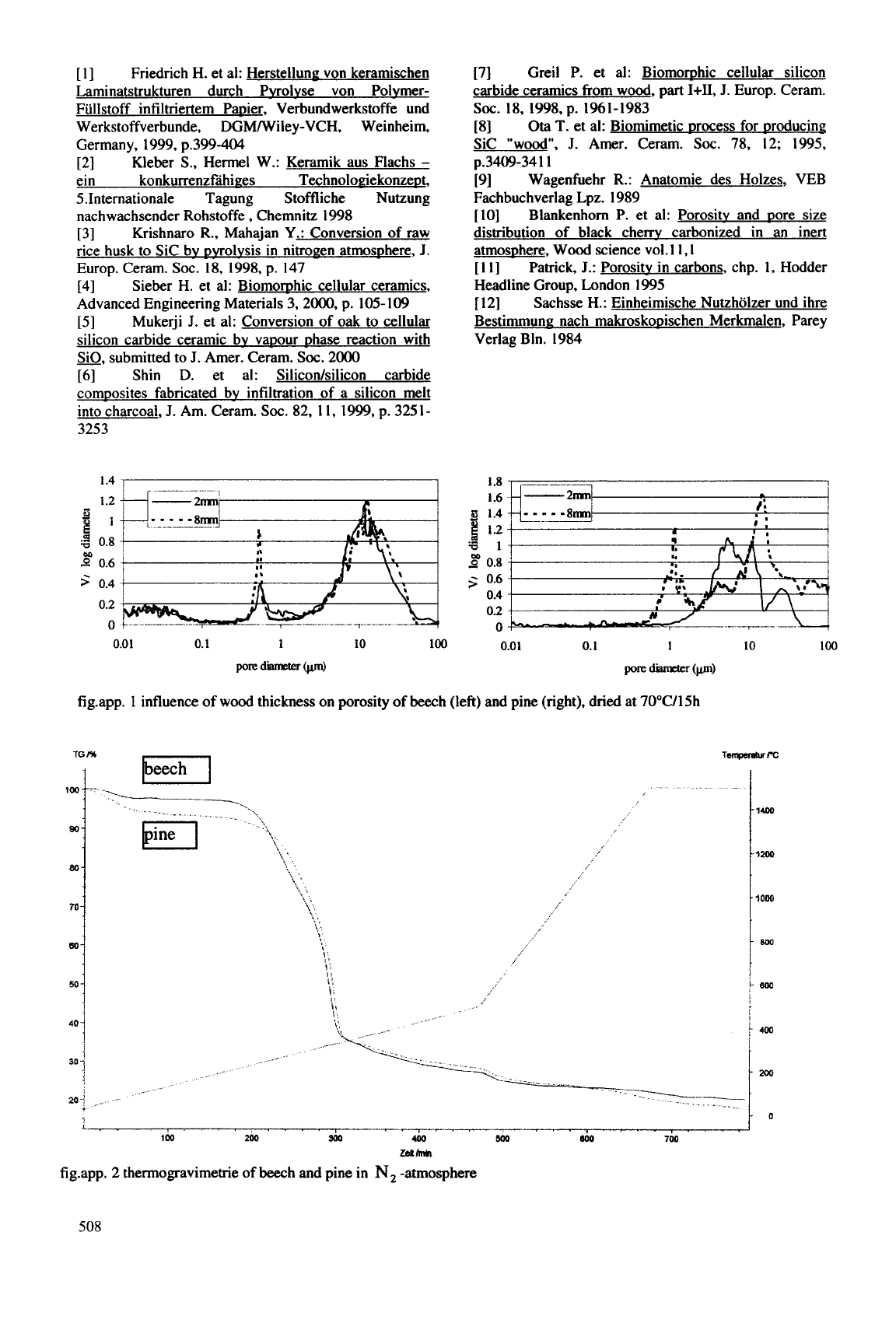
[
13
Friedrich H. et al: Herstellung von keramischen
Laminatstrukturen durch Pvrolyse von Polymer-
Fullstoff infiltriertem PaDier, Verbundwerkstoffe und
Werkstoffverbunde, DGM/Wiley-VCH, Weinheim,
Germany, 1999, p.399-404
[2]
Kleber
S.,
Hermel W.: Keramik aus Flachs
-
ein konkurrenzfahiges Technoloeiekonzept,
5.Internationale Tagung Stoffliche Nutzung
nachwachsender Rohstoffe
,
Chemnitz
1998
[3]
Krishnaro
R.,
Mahajan
Y.:
Conversion of raw
rice husk to Sic bv pvrolvsis in nitrogen atmosphere,
J.
Europ. Ceram. SOC.
18,
1998, p. 147
[4] Sieber
H.
et al: Biomorphic cellular ceramics,
Advanced Engineering Materials 3,2000, p. 105-109
[5]
Mukerji
J.
et al: Conversion of oak to cellular
silicon carbide ceramic bv vapour Dhase reaction with
-
SiO, submitted to
J.
Amer. Ceram.
Soc.
2000
[6] Shin D. et al: Silicon/silicon carbide
comDosites fabricated by infiltration of a silicon melt
into charcoal,
J.
Am. Ceram.
Soc.
82,
1
1,
1999, p. 3251-
3253
[7]
Greil P. et al: Biomorphic cellular silicon
carbide ceramics from wood, part I+II,
J.
Europ. Ceram.
[8]
Ota
T. et al: Biomimetic Drocess for producing
Sic "wood",
J.
Amer.
Ceram.
Soc.
78, 12; 1995,
[9] Wagenfuehr
R.:
Anatomie des Holzes, VEB
Fachbuchverlag Lpz. 1989
[lo]
Blankenhorn P. et al: Porositv and Dore size
distribution of black cherry carbonized in an inert
atmomhere, Wood science vol.
1
1,1
[
1
I]
Patrick,
J.:
Porositv in carbons, chp.
1,
Hodder
Headline Group, London 1995
[
121 Sachsse H.: Einheimische Nutzholzer und ihre
Bestimmung nach makroskoDischen Merkmalen, Parey
Verlag Bin. 1984
SW.
18,
1998,
p. 1961-1983
p.3409-3411
1.8
1.6
1
;:;
.-
-01
3
0.8
5
0.6
0.4
0.2
0
0.0
I
0.1
1
10
100
0.01
0.1
1
10
100
pore
diamter
(pm)
pore
-
(p)
fig.app.
1
influence
of
wood
thickness on porosity of beech (left) and pine (right), dried at 70°C/15h
508
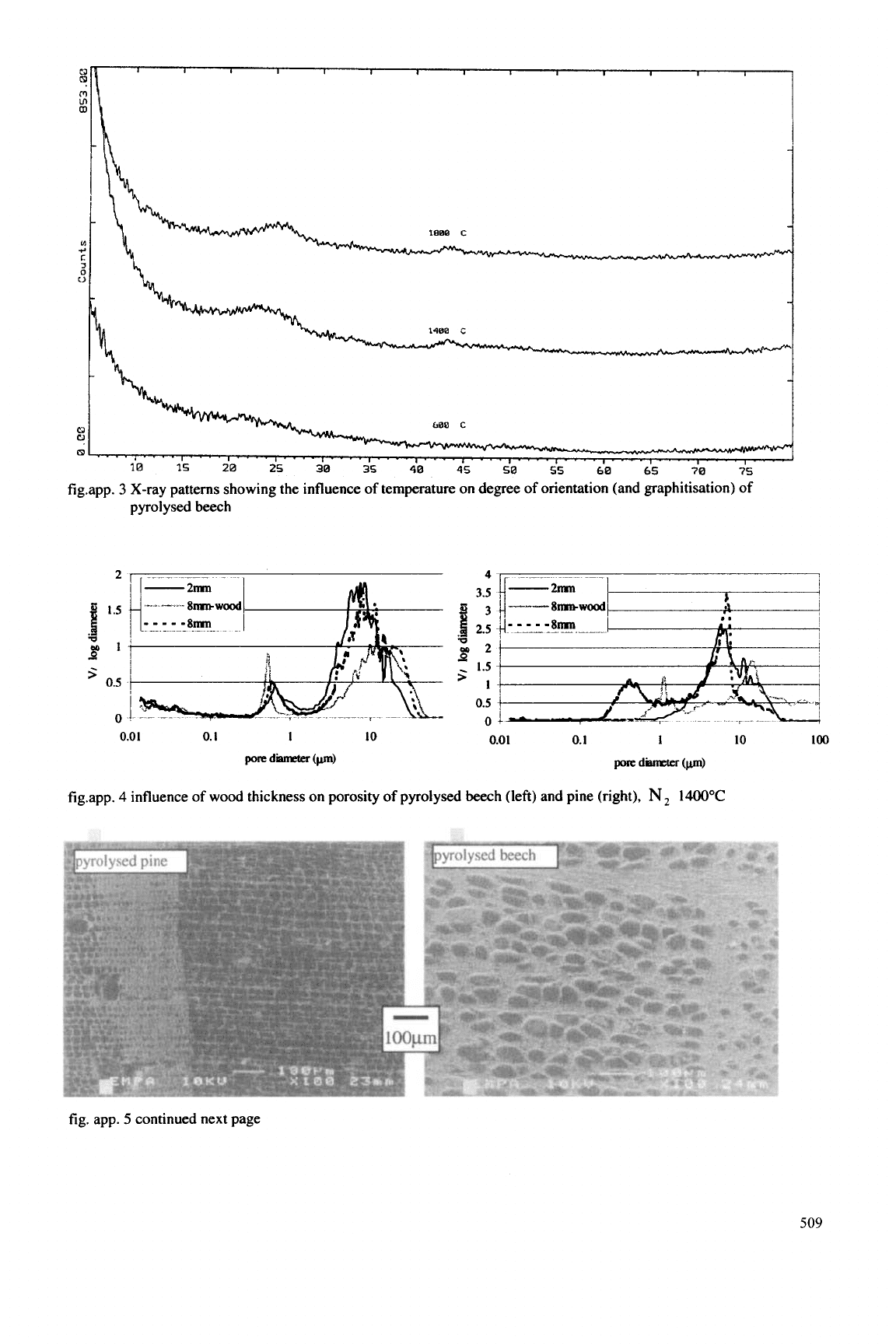
CJ-
c?
rn
Ln
m
0.01
0.1
1
10
pore
diameter
(p)
I I
I
I I
I
1
8
I
I I
I
t
0.01
0.1
1
10
100
pore
dwr(CII11)
fig.app.
4
influence
of
wood thickness
on
porosity
of
pyrolysed beech
(left)
and pine (right),
N,
1400OC
fig. app.
5
continued next page
509

fig.app.
5
SEM
micrographs of pyrolysed and
infiltrated pine (left) and beech (right)
fig.app.
6
Morphology of Sic derived from pyrolysed pine (left) and beech (tight), close
to
silicon vapour source
fig.app.
7
influence of relative Si(,,-source position on microstructure
of
Sic in
beech,
samples with 8mm thickness
510
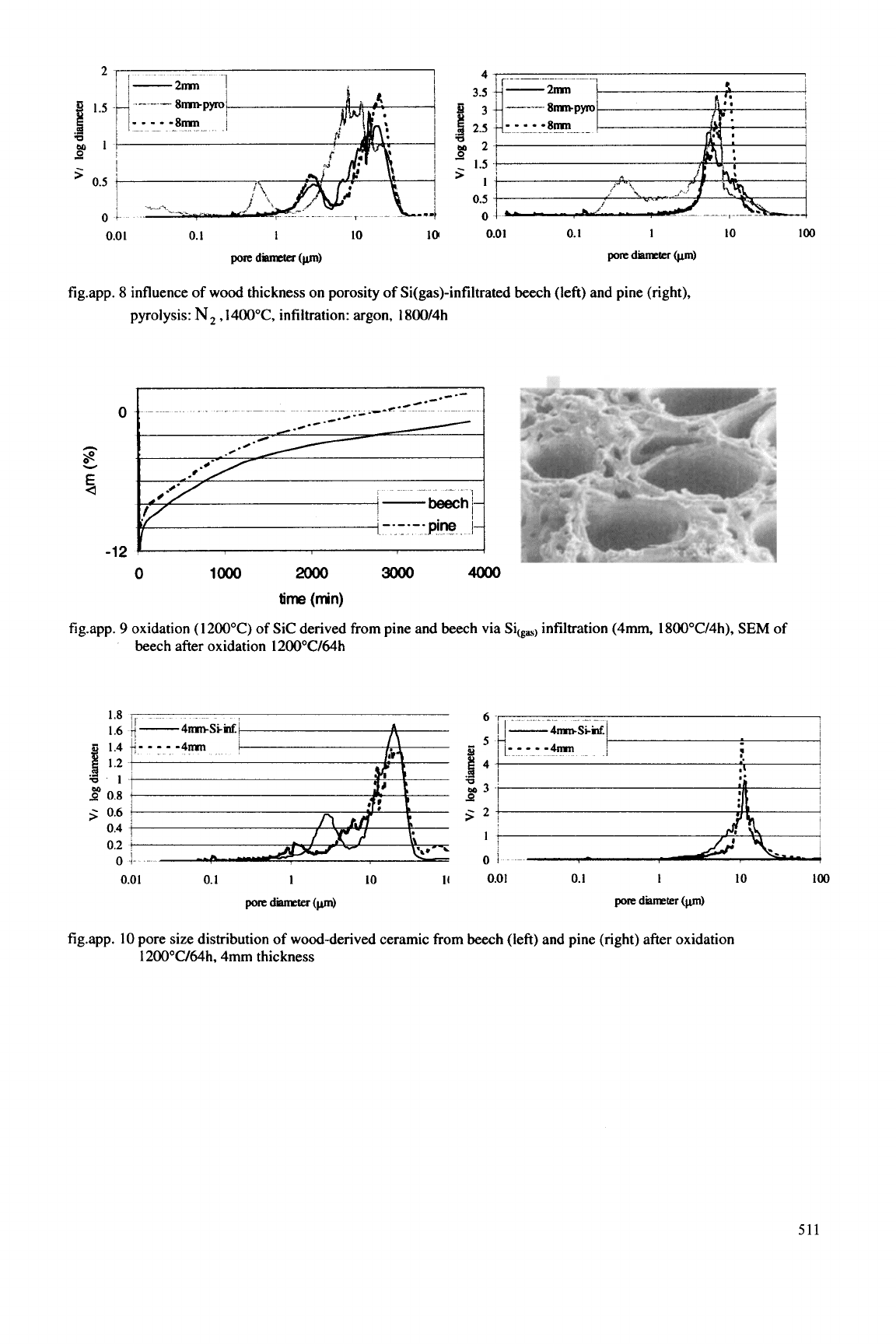
0.01
0.
I
1
10
10
0.0
1
0.1
1
10
100
pore
dim
(pl)
pore dhm%e.r
(rvn,
fig.app.
8
influence
of
wood
thickness on porosity
of
Si(gas)-infiltrated beech (left) and pine (right),
pyrolysis:
N
,
1400°c, infiltration: argon, 1800/4h
0
-12
0
lo00
2Ooo
3Ooo
4Ooo
time
(min)
beech after oxidation 1200'C/64h
fig.app.
9
oxidation
(I
200°C)
of
Sic derived from pine and beech via S&,) infiltration (4mm.
1
800"C/4h),
SEM
of
1.8
,
0.01
0.1
1
10
11
0.01
0.1
I
10
loo
pore
dmter
(rUn,
pore
dmter
(p)
fig.app.
10
pore size distribution
of
wood-derived ceramic from beech (left) and pine (right) after oxidation
1
200"C/64h, 4mm thickness
511
